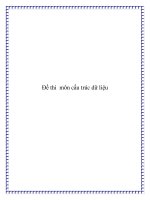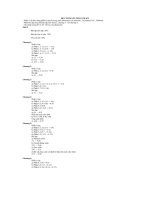Đề thi môn cân bằng vật liệu
Bạn đang xem bản rút gọn của tài liệu. Xem và tải ngay bản đầy đủ của tài liệu tại đây (218.57 KB, 3 trang )
��������������������������������������
������
�����������������
������������������������
����������������������������������������������������
����������������������
���������������
Total Mass Balance
ⅆ
ⅆ�
ρ ⅆ� +
(�)
ρ (� - �) · � ⅆ � = �
(�)
Species Mass Balance (no reactions)
ⅆ
ⅆ�
ρ� ⅆ � +
(�)
ρ� (�� - �) · � ⅆ � = �� � = �� �� …� �
(�)
���������������������
The species mass density of a three-component (A, B, and C) liquid mixture are: acetone,
ρA = 326.4 kgm3 , acetic acid ρB = 326.4 kgm3 , and ethanol ρC = 217.6 kgm3 . Determine the following
for this mixture:
(a) the mass fraction of each species in the mixture
(b) the mole fraction of each species in the mixture
(c) the mass of each component required to make one cubic metter of the mixture. Note that the molecular masses of the three species are
MWA = 58.08 g/mol, MWB = 60.05 g/mol, MWC = 46.07 g/mol.
���������������������
A variety of devices, such as ram pumps, hydraulic jacks, and shock absorbers, make use of moving
solid cylinders to generate a desired fluid motion. In the Figure below we have illustrated a cylindrical
rod entering a cylindrical cavity in order to force the fluid out of the cavity. In order to determine the
force acting on the cylindrical rod, we must know the velocity of the fluid in the annular region. If density
of the fluid can be treated as a constant, the velocity can be determined by application of the macroscopic mass balance and in this problem you are asked to develop a general representation for the fluid
velocity.
2 ���
ECH51FirstPracticeExam_2016.nb
���������������������
In a four stage evaporation system shown in Figure below, a 50% by weight sugar solution is concentrated to 75% by weight in the liquid stream leaving the fourth evaporator. Pure water leaves each
evaporator with a mass flow rate of mB . The mass flow rate entering the system is 100 kg/min, and you
are asked to determine the composition of the sugar solution leaving the second evaporator. In your
analysis, let the sugar be species A and the water be species B. Assume that a degree-of-freedom
analysis has been carried out and that the problem is well-posed.
�
�
�
�
�
�
�
�
Problem 4 (15 points)
Liquid acetone (C3 H6 O, species A) is fed (Stream #1) a rate of 0.400 m3 /min into a heated evaporator,
where it evaporates into a nitrogen stream that enters the evaporator as Stream #2. The gas mixture
leaving the evaporator Stream #3 is diluted by another nitrogen stream (Stream #4) flowing at a measured rate of 419 m3 (STP)/min. The combined gases (Stream #5) are then compressed together and
leave the compressor at a total pressure of 5550 mm Hg and temperature of 325°C (Stream #6). The
partial pressure of acetone in the exit stream (Stream #6) is pA = 500 mm Hg. The ambient pressure is
763 mm Hg. A schematic of the flow is shown below
ECH51FirstPracticeExam_2016.nb
���
�������
(i) What are the molar flow rates of N2 and acetone in the stream leaving the compressor (Stream #6)?
(ii) What is the volumetric flow rate of nitrogen entering the evaporator (Stream #2) if the temperature
and pressure of this stream are 27°C and 1238 mm Hg ?
Data given:
1 mol =0.0224 m3 (STP) , ρA = 0.791 gcm3 , A = 58.06 g/mol
The partial pressure is related to the total pressure by: pA = yA P, where yA is the mole fraction of
species A. Yopu may assume that all the gas streams behave as ideal gas mixture, and the ideal gas
law is PV=n RT, where n is the number of moles.
3









